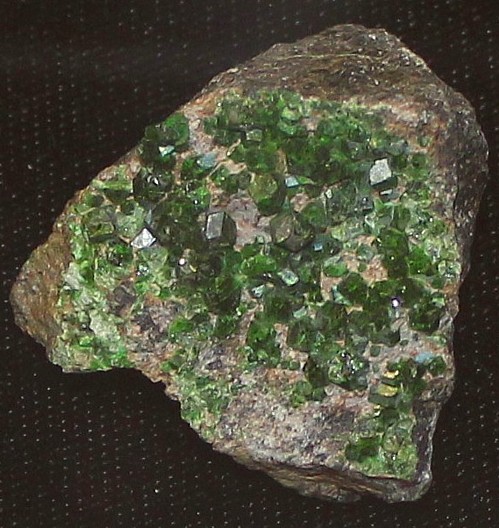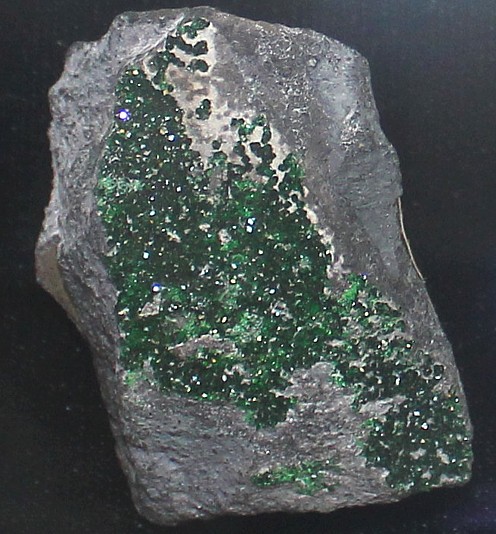|
.
Uvarovite Mineral Facts:
Chemical Formula:
Ca3Cr2(SiO4)3
Calcium
aluminum garnet. Often contains ferrous iron replacing calcium and
ferric iron or aluminum replacing chromium.
Colors:
Emerald Green of various shades.
Colored green by Chromium.
Hardness:
2.0 to 2.5
Density: 3.42
Cleavage:
None.
Crystallography: Isometric, hexoctahedral
Usually distinctly
crystallized forming fine drusy crystals of small size. Larger sizes and
single crystals rare. Common forms are the dodecahedron and trapezohedron, often
in combination. Hexoctahedron observed at times.
Luster:.
Vitreous glassy
luster. It is transparent or translucent.
Optics:
(Refractive Index):
=
1.8384.
|

Green Uvarovite Garnet |
|
Composition,
Structure and Associated Minerals:
Uvarovite is the rarest of the commonly occuring garnets. It is named
after Count
Sergey
Uvarov of
Russia, who was a
statesman and amateur mineral collector.
It
is found in few geologic environments, occurring only with chromite in
serpentine.
It is formed by hydrothermal alteration of
chromium bearing serpentinite, metamorphosed limestones and skarns. To form
uvarovite, significant chromium, normally in the form of chromite, must be
present. It is found
with chrome ore at Bissersk and Kyschtim in the Urals, in South Africa and
Finland.
Fine uvarovite specimens have been found
in eastern Finland at the Outokumpu ore field where ophiolite-related
stratiform massive Cu-Zn-Co sulphides with disseminated sulphide Nickel ore
and other massive stratiform sulphides occur in serpentinite, quartz-rock
and calc-silicate rock.
Uvarovite
has also been found in the US associted with chrome deposits in serpentine
in
the
chromite mines of California at New Idria and elsewhere in the state as
well as in the chromite mines of Texas, and Pennsylvania.
Colored green
by its essential chromium content, it is always some shade of deep green.
The name has frequently been misused in the past to refer to other
green colored or chromium bearing garnets, because it is difficult to
determine the actual chromium content without destructive chemical analysis.
As a result many garnets termed Uvarovite are actually chromium
bearing Grossular, chromian Pyrope, or green Andradite (the so-called
Iranian 'uvarovite').
|

|
|
|
Identification
and Diagnostics
Before the
blowpipe, infusible alone and without fluxes. Gives a clear chrome green
borax bead (positive test for chromium).
Garnets, when in crystals, are easily distinguished from other similarly
crystallizing substances by their characteristic isometric crystals, color
and hardness, etc. Massive garnet may resemble vesuvianite,
sphene, zircon or
tourmaline. It is distinguished from
zircon by its easier fusibility and from vesuvianite by its more difficult
fusibility; from tourmaline by its higher specific gravity, and from sphene
by the reaction from titanium.
It frequently requires a chemical
analysis to positively distinguish between the different members of the
group, or the percentages of each element in an individual specimen..
Occurrence,
Localities and Origins:
Uvarovite
is not found in crystals large enough for faceted gems. What few crystals of
any size that are found are not clean enough to facet. If clean stones of
decent color and clarity could be found, they would be of great value as a
gemstone because of its desirable color. It receives some sparse use in
druse jewelry where its natural crystal faces sparkle. The Ural Mts.
of Russia are still the major source for the attractive Uvarovite drusy that
is used in jewelry.
Return to the
Mineral Collectors Information Page
|
|


